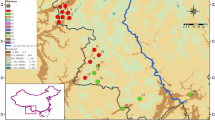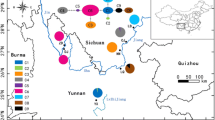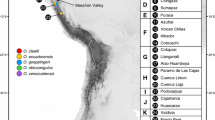Abstract
A phylogeographic approach was conducted to assess the geographic structure and genetic variation in populations of the boll weevil Anthonomus grandis, which is the most harmful insect pest of cotton in the Americas. COI and COII mitochondrial gene sequences were analyzed to test a former hypothesis on the origin of the boll weevil in Argentina, Brazil and Paraguay, using samples from Mexico and USA as putative source populations. The analysis of variability suggests that populations from South American cotton fields and nearby disturbed areas form a phylogroup with a central haplotype herein called A, which is the most common and widespread in USA and South America. The population from Texas has the A haplotype as the most frequent and gathers in the same group as the South American populations associated with cotton. The sample from Tecomán (México) shows high values of within-nucleotide divergence, shares no haplotype in common with the South American samples, and forms a phylogroup separated by several mutational steps. The sample from Iguazú National Park (Misiones Province, Argentina) has similar characteristics, with highly divergent haplotypes forming a phylogroup closer to the samples from cotton fields, than to the Mexican group. We propose that in South America there are: populations with characteristics of recent invaders, which would be remnants of “bottlenecks” that occurred after single or multiple colonization events, probably from the United States, and ancient populations associated with native forests, partially isolated by events of historical fragmentation.
Similar content being viewed by others
References
A.N. Ab’Sáber (1977) ArticleTitleEspaços ocupados pela expansão dos climas secos na America do Sul, por ocasião dos períodos glaciais Quaternários Paleoclimas, Univ. São Paulo, Inst. de Geografía 3 1–19
R.S. Anderson (1993) ArticleTitleWeevil and plants: phylogenetic versus ecological mediation of evolution of host plant associations in Curculioninae (Coleoptera: Curculionidae) Mem. Entomol. Soc. Can. 165 197–232
Axelrod, D.I., 1950. Studies in late Tertiary palobotany. Carnegie Inst. Wash., Publ. 590.
D.I. Axelrod (1958) ArticleTitleEvolution of the Madro-Tertiary flora Bot. Rev. 24 433–509
J.C. Avise (2000) Phylogeography: the history and formation of species Harvard Univ. Press Cambridge, MA
J.C. Avise D. Walker (1998) ArticleTitlePleistocene phylogeographic effects on avian populations and the speciation process Proc. Roy. Soc. Lond. B 265 457–463 Occurrence Handle1:STN:280:DyaK1c3jtFWhsQ%3D%3D
J.C. Avise J. Arnold R.M. Ball E. Bermingham T. Lamb J.E. Neigel et al. (1987) ArticleTitleIntraspecific phylogeography: the mitochondrial DNA bridge between population genetics and systematics Ann. Rev. Ecol. Syst. 18 489–522
J.K. Becerra (1997) ArticleTitleInsects on plants: macroevolutionary chemical trends in host use Science 276 253–256 Occurrence Handle10.1126/science.276.5310.253 Occurrence Handle9092474 Occurrence Handle1:CAS:528:DyaK2sXisFWnur0%3D
J.K. Becerra L. Venable (1999) ArticleTitleMacroevolution of insect-plant associations. The relevance of host biogeography to host association Proc. Nat. Acad. Sci. USA 96 12626–12631 Occurrence Handle10.1073/pnas.96.22.12626 Occurrence Handle10535973 Occurrence Handle1:CAS:528:DyaK1MXnt1yqs7o%3D
D. Bensansson D. Zhang G.M. Hewitt (2000) ArticleTitleFrequent assimilation of mitochondrial DNA by grasshopper nuclear genomes Mol. Biol. Evol. 17 IssueID3 406–415
E.A. Bernays R.F. Chapman (1994) Host-plant selection by Phytophagous Insects Chapman & Hall New York
C.L. Brubaker J.F. Wendel (1994) ArticleTitleReevaluating the origin of domesticated cotton (Gossypium hirsutum: Malvaceae) using nuclear restriction fragment length polymorphisms (RFLPs) Am. J. Bot. 81 1309–1326
Burke, H.R., 1968. Geographic variation and taxonomy of Anthonomus grandis Boheman. Dept. Entomol. Texas A. & M. Univ.
H.R. Burke (1976) ArticleTitleBionomics of the anthonomine weevils Annu. Rev. Entomol. 21 283–303 Occurrence Handle10.1146/annurev.en.21.010176.001435
H.R. Burke J.R. Cate (1979) ArticleTitleA new species of Mexican Anthonomus related to the boll weevil (Coleoptera: Curculionidae) Ann. Entomol. Soc. Am. 72 189–192
Burke, H.R. & W.E. Clark, 1976. Cienfuegosia drumondii as a host of the boll weevil, Anthonomus grandis Boheman, in south Texas. Proceedings, Boll Weevil Suppression, Management and Elimination Technology, pp.13–15.
H.R. Burke W.E. Clark J.R. Cate P.A. Fryxell (1986) ArticleTitleOrigin and dispersal of the boll weevil Bull. Entomol. Soc. Am. 32 228–238
H.R. Burke W.E. Clark W.H. Cross (1984) ArticleTitleLarvae and pupae of the Anthonomus subgenus Anthonomorphus Dietz, A. grandis Boheman and A. hunteri Burke and Cate (Coleoptera: Curculionidae) Southwest. Entomol. 9 IssueID1 84–90
H.R. Burke W.H. Cross (1966) ArticleTitleA new species of Anthonomus attacking cotton in Colombia, with a review of the taxonomy of Anthonomus vestitus (Coleoptera: Curculionidae) Ann. Entomol. Soc. Am. 59 IssueID5 924–931
A.L. Cabrera A. Willink (1980) Biogeografía de América Latina EditionNumber2 Serie de Biología. Sec. Gral. OEA Washington, D. C
W.E. Clark (1988) ArticleTitleRevision of the weevil genus Loncophorus Chevrolat (Coleoptera: Curculionidae, Anthonominae) Quaest. Entomol. 24 465–520
W.E. Clark (1995) ArticleTitleA new species of Loncophorus from Mexico (Coleoptera: Curculionidae: Anthonomini) associated with Mortoniodendron (Malvales: Tiliaceae) An. Inst. Biol. UNAM, Serie Zool. 66 107–112
W.E. Clark H.R. Burke (1986) ArticleTitlePhylogeny of the species of the Anthonomus subgenus Anthonomorphus Dietz, with discussion of relationships with Anthonomus grandis Boheman (Coleoptera: Curculionidae) J. Kansas. Entomol. Soc. 59 IssueID3 508–516
D.O. Clary D.R. Wolstenholme (1985) ArticleTitleThe mitochondrial DNA molecule of Drosophila yacuba: nucleotide sequence, gene organization and genetic code J. Mol. Evol. 22 252–271 Occurrence Handle10.1007/BF02099755 Occurrence Handle3001325 Occurrence Handle1:CAS:528:DyaL28Xht1eqtb4%3D
V.A. Confalonieri A.S. Sequeira L. Todaro J.C. Vilardi (1998) ArticleTitleMitochondrial DNA phylogeography of the grasshopper Trimerotropis pallidipennis in relation to clinal distribution of chromosome polymorphisms Heredity 81 444–452 Occurrence Handle10.1038/sj.hdy.6884050 Occurrence Handle1:CAS:528:DyaK1cXnslKhtro%3D
V.A. Confalonieri A.A. Scataglini M.I. Remis (2002) ArticleTitleSequence differentiantion among inversion rearramgements are revealed by RAPD markers in the grasshopper Trimerotropis pallidipennis (Orthoptera) Ann. Entomol. Society of America 95 IssueID2 201–207 Occurrence Handle1:CAS:528:DC%2BD38Xis1altr0%3D
L. Croizat G. Nelson D.E. Rosen (1974) ArticleTitleCenters of origin and related concepts Syst. Zool. 23 265–287
W.H. Cross M.J. Lukefahr P.A. Fryxell H.R. Burke (1975) ArticleTitleHost plants of the boll weevil Environ. Entomol. 4 19–26
W.L. Donn W.R. Farrand M. Ewing (1962) ArticleTitlePleistocene ice volumes and sea-level lowering Jour. Geol. 63 538–578
B.C. Emerson P. Oromí G.M. Hewitt (2000) ArticleTitleColonization and diversification of the species Brachyderes rugatus (Coleoptera) on the Canary Islands: evidence from mitochondrial DNA COII gene sequences Evolution 54 IssueID3 911–923 Occurrence Handle10937264 Occurrence Handle1:CAS:528:DC%2BD3cXlsVSmsL4%3D
J. Felsenstein (1981) ArticleTitleEvolutionary trees from DNA sequences: a maximum likelihood approach J. Mol. Evol. 17 368–376 Occurrence Handle10.1007/BF01734359 Occurrence Handle7288891 Occurrence Handle1:CAS:528:DyaL3MXls1Cisr8%3D
P.A. Fryxell (1965) ArticleTitleStages in the evolution of Gossypium L Adv. Front. Plant. Sci. 10 31–56
P.A. Fryxell (1979) The natural history of the cotton tribe (Malvaceae, tribe Gossypieae) Texas A&M Univ College Station and London
P.A. Fryxell M.J. Lukefahr (1967) ArticleTitleHampea Schlecht: possible primary host of the cotton boll weevil Science 155 1568–1569
P.A. Goloboff (1994) NONA/Pee-Wee, ver. 1.1 The American Museum of Natural History New York
Gutiérrez, M, Ricciardi A.A., Vrdoljak J., Galván A.C.A., Carnevali R., 1960. Algodones barbadenses indígenas de la Argentina. Recolección de material y formación de una colección. Bol N ° 8, INTA, Centro Regional Chaqueño, Argentina, pp. 1–50.
N. Guzmán V. Lía A. Lanteri V. Confalonieri (2004) ArticleTitlePosibles focos naturales de dispersión del picudo del algodonero detectados en Misiones mediante marcadores RAPDs de alta resolución J. Basic Appl. Genet. 16 140
J.L. Haffer (1977) ArticleTitlePleistocene speciation in Amazonian birds Amazonia 6 161–192
J.L. Haffer (1982) General aspects of the refuge theory G.T. Prance (Eds) in Biological Diversification in the Tropics Columbia Univ. Press New York 6–24
G. Halffter (1964) ArticleTitleLa entomofauna americana. Ideas acerca de su origen y distribución Folia Entomol. Mex. 6 1–108
G. Halffter (1974) ArticleTitleElements anciens de l’entomofaune neotropicale: ses implications biogeographiques Quaest. Entomol. 10 223–262
J.P. Huelsenbeck F. Ronquist (2001) ArticleTitleMRBAYES: Bayesian inference of phylogenetic trees Bioinformatics 17 754–755 Occurrence Handle10.1093/bioinformatics/17.8.754 Occurrence Handle11524383 Occurrence Handle1:STN:280:DC%2BD3MvotV2isw%3D%3D
J.B. Hutchinson R.A. Silow S.G. Stephens (1947) The evolution of Gossypium Oxford Univ. Press London, U.K
R.W. Jones (2001) ArticleTitleEvolution of the host plant associations of the Anthonomus grandis species group (Coleoptera: Curculionidae): phylogenetic test of various hypothesis Ann. Entomol. Soc. Am. 94 IssueID1 51–58
R.W. Jones H.R. Burke (1997) ArticleTitleNew species and host plants of the Anthonomus grandis species group (Coleoptera: Curculionidae) Proc. Entomol. Soc. Wash. 99 IssueID4 705–719
R.W. Jones P.A. Fryxell D.M. Baro (1997) ArticleTitlePhylogenetic analysis of the genus Hampea (Malvales: Malvaceae: Gossypiae) An. Inst. Biol. UNAM, Ser. Bot. 68 IssueID1 21–42
K.S. Kim T.W. Sappington (2004) ArticleTitleBoll weevil (Anthonomus grandis Boheman) (Coleoptera: Curculionidae) dispersal in the southern United States: evidence from mitochondrial DNA variation Environ. Entomol. 33 457–470
Krapovickas, A., 2000. El género Cienfuegosia y el “picudo del algodonero” al sur del trópico, en Sudamérica. III International Workshop on Integrated Pest Management of the Cotton Boll Weevil in Argentina, Brazil and Paraguay, Workshop Proceedings p. 43.
Kumar, S., Tamura K., Jacobsen I., Nei M., 2001. Molecular Evolutionary Genetics Analysis (MEGA). Version 2.1.
D.W. Langor F.A.H. Sperling (1997) ArticleTitleMitochondrial DNA sequence divergence in weevils of the Pissodes strobi species complex (Coleoptera: Curculionidae) Insect Mol. Biol. 6 IssueID3 255–265 Occurrence Handle10.1046/j.1365-2583.1997.00180.x Occurrence Handle9272443 Occurrence Handle1:CAS:528:DyaK2sXlsVCrs7Y%3D
A.A. Lanteri V.A. Confalonieri (2003) Filogeografía: objetivos, métodos y ejemplos J. Llorente Bousquets J.J. Morrone (Eds) Introducción a la Biogeografía en Latinoamérica: Conceptos, teorías, métodos y aplicaciones NumberInSeriesVol. II Facultad de Ciencias UNAM, México 185–193
A.A. Lanteri M.S. Loiácono A.E. Marvaldi (2002) ArticleTitleAnthonomus (Coleoptera: Curculionidae) asociados con el algodonero en la Argentina Rev. Soc. Entomol. Argent. 61 IssueID3–4 24–26
A.A. Lanteri A. Marvaldi S. Suárez (2002) ArticleTitleGorgojos de la Argentina y sus plantas huéspedes. Tomo I: Apionidae y Curculionidae Publ. Especial SEA 1 1–96
V.V. Lia V.A. Confalonieri C.I. Comas J.H. Hunziker (2001) ArticleTitleMolecular phylogeny of Larrea and its allies (Zygophyllaceae): Reticulate evolution and the probable time of Creosote Bush arrival to North America Mol. Phyl. Evol. 21 IssueID2 309–320 Occurrence Handle1:CAS:528:DC%2BD3MXotVynu78%3D
G. Litzenberger W. Chapco (2001) ArticleTitleA molecular phylogeographic perspective on a fifty-year-old taxonomic issue in grasshopper systematics Heredity 86 54–59 Occurrence Handle10.1046/j.1365-2540.2001.00806.x Occurrence Handle11298815 Occurrence Handle1:CAS:528:DC%2BD3MXjtFyjtbg%3D
H. Liu A. Beckenbach (1992) ArticleTitleEvolution of the Cytochrome Oxidase II gene among 10 orders of insects Mol. Phyl. Evol. 1 41–52 Occurrence Handle1:CAS:528:DyaK3sXksVahurk%3D
D. Lunt K. Ibrahim G. Hewitt (1998) ArticleTitlemtDNA phylogeography and postglacial patterns of subdivision in the meadow grasshopper Chorthippus parallelus Heredity 80 633–641 Occurrence Handle10.1038/sj.hdy.6883110 Occurrence Handle9650281 Occurrence Handle1:CAS:528:DyaK1cXktVCis7k%3D
D.H. Lunt D.X. Zhand J.M. Szymura G.M. Hewitt (1996) ArticleTitleThe insect cytochrome oxidase I gene evolutionary patterns and conserved primers for phylogenetic studies Insect Mol. Biol. 5 IssueID3 153–165 Occurrence Handle8799733 Occurrence Handle1:CAS:528:DyaK28XjvVGjur0%3D
Manessi, O. G., 1997. Anthonomus grandis Boh. “El picudo del algodonero” “La super plaga”. FULCPA, Buenos Aires.
J.J. Morrone (2000) ArticleTitleWhat is the Chacoan subregion? Neotropica 45 51–68
J.J. Morrone (2001) ArticleTitleThe Parana subregion and its provinces Physis (Buenos Aires) 58 IssueID134–135 1–7
Morrone, J.J., 2002. Presentación sintética de un nuevo esquema biogeográfico de América Latina y el Caribe. pp. 267–275, in Proyecto de Red Iberoamericana de Biogeografía y Entomología Sistemática, edited by C. Costa, S.A. Vanin, J.M. Lobo & A.Melic, PrIbes 2002.
M. Nei (1987) Molecular Evolutionary Genetics Columbia Univ. Press New York
M. Nei S. Kumar (2000) Molecular Evolution and Phylogenetics Oxford Univ. Press New York
G. Nelson N.I. Platnick (1981) Systematics and Biogeography: Cladistics and Vicariance Columbia University Press New York
B.B. Normark (1996) ArticleTitlePhylogeny and evolution of parthenogenetic weevils of the Aramigus tessellatus species complex (Coleoptera: Curculionidae: Naupactini): Evidence from mitochondrial DNA sequences Evolution 50 734–745 Occurrence Handle1:CAS:528:DyaK28Xjtleltb8%3D
B.B. Normark A.A. Lanteri (1998) ArticleTitleIncongruence between morphological and mitochondrial DNA characters suggests hybrid origins of parthenogenetic weevil lineages (genus Aramigus) Syst. Biol. 47 IssueID3 475–494 Occurrence Handle12066688 Occurrence Handle1:STN:280:DC%2BD38zitlenuw%3D%3D
G.F. Phillips (1963) ArticleTitleThe cytogenetics of Gossypium and the origin of New World cottons Evolution 17 460–469
D. Posada K.A. Crandall (1998) ArticleTitleModeltest: Testing the model of DNA substitution Bioinformatics 14 817–818 Occurrence Handle10.1093/bioinformatics/14.9.817 Occurrence Handle9918953 Occurrence Handle1:CAS:528:DyaK1MXktlCltw%3D%3D
D.E. Prado P.E. Gibbs (1993) ArticleTitlePatterns of species distributions in the dry seasonal forests of South America Ann. Miss. Bot. Garden 80 IssueID4 903–927
G.T. Prance (Eds) (1982) Biological diversification in the tropics Columbia Univ. Press New York
P.H Raven (1963) ArticleTitleAmphitropical relationships in the floras of North and South America Quatern. Rev. Biol. 38 151–177
P.H. Raven D.I. Axelrod (1975) ArticleTitleHistory of the flora and fauna of Latin America Am. Scient. 63 IssueID4 420–429
R.A. Reiss D.P. Schwert A.C. Ashworth (1995) ArticleTitleField preservation of Coleoptera for molecular genetics analyses Environ. Entomol. 24 IssueID3 716–719
R.L. Roehrdanz (2001) ArticleTitleGenetic differentiation of Southeastern boll weevil and Thurberia weevil populations of Anthonomus grandis (Coleoptera: Curculionidae) using mitochondrial DNA Ann. Entomol. Soc. Am. 94 IssueID6 928–935 Occurrence Handle1:CAS:528:DC%2BD38Xht1anug%3D%3D
R.L. Roehrdanz D.T. North (1992) ArticleTitleMitochondrial DNA restriction fragments variation and biosystematics of the boll weevil, Anthonomus grandis Southwest. Entomol. 17 IssueID2 101–108
J Rzedowski (1993) Diversity and origins of the Phanerogamic flora of Mexico T.P. Ramamoorthy R. Bye A. Lot J. Fa (Eds) Biological diversity of Mexico. Origins and distribution Oxford Univ. Press New York 129–146
M.A. Scataglini V.A. Confalonieri A.A. Lanteri (2000) ArticleTitleDispersal of the cotton boll weevil in South America: evidence of the RAPDs analysis Genetica 108 127–136 Occurrence Handle10.1023/A:1004163820446 Occurrence Handle11138940 Occurrence Handle1:CAS:528:DC%2BD3MXkvVyktA%3D%3D
M.A. Scataglini A.A. Lanteri V.A. Confalonieri (2005) ArticleTitlePhylogeny of the Pantomorus-Naupactus complex based on morphological and molecular data (Coleoptera: Curculionidae) Cladistics 21 131–142 Occurrence Handle10.1111/j.1096-0031.2005.00055.x
A. Sequeira A.A. Lanteri M.A. Scataglini V.A. Confalonieri B. Farell (2000) ArticleTitleAre flightless Galapaganus weevils older than the Galápagos Islands they inhabit? Heredity 85 20–29 Occurrence Handle10.1046/j.1365-2540.2000.00690.x Occurrence Handle10971687
L. Schoonhoven T. Jermy J.J.A. Loon ParticleVan (1998) Insect-plant biology Chapman & Hall London
B. Simpson Vuilleumier (1971) ArticleTitlePleistocene changes in the fauna and flora of South America Science 173 771–780
R.L. Small J.F. Wendel (2000) ArticleTitlePhylogeny, duplication and intraspecific variation of Adh sequences in New World diploid cottons (Gossypium L., Malvaceae) Mol. Phyl. Evol. 16 IssueID1 73–84 Occurrence Handle1:CAS:528:DC%2BD3cXksVaqtrY%3D
M.D. Sorenson R.C. Fleischer (1996) ArticleTitleMultiple independent transposition of mitochondrial DNA control region sequences to the nucleus Proc. Natl. Acad. Sci. USA 93 15239–15243 Occurrence Handle10.1073/pnas.93.26.15239 Occurrence Handle8986794 Occurrence Handle1:CAS:528:DyaK2sXntFGr
D.L. Swofford (1998) PAUP*: Phylogenetic Analysis Using Parsimony (and other methods). Ver. 4.0b10 Sinauer Associates Sunderland, MA
F. Tajima M. Nei (1982) ArticleTitleBiases of the estimates of DNA divergence obtained by the restriction enzyme technique J. Mol. Evol. 17 115–120
K. Tamura M. Nei (1993) ArticleTitleEstimation of the number of nucleotide substitution in the control region of mitochondrial DNA in humans and chimpanzees Mol. Biol. Evol. 10 512–526 Occurrence Handle8336541 Occurrence Handle1:CAS:528:DyaK3sXks1CksL4%3D
J.D. Thompson D.G. Higgins T.J. Gibson (1994) ArticleTitleCLUSTAL W: Improving the sensitivity of progressive multiple sequence alignment through sequence weighting, position specific gap penalties and weight matrix choice Nucleic Acids Res. 22 4673–4680 Occurrence Handle7984417 Occurrence Handle1:CAS:528:DyaK2MXitlSgu74%3D
J.F. Wendel A. Schnabel T. Seelanan (1995) ArticleTitleAn unusual ribosomal DNA sequence from Gossypium gossypioides reveals ancient, cryptic, intergenomic introgression Mol. Phyl. Evol. 4 298–313 Occurrence Handle1:CAS:528:DyaK2MXptFShurw%3D
D.X. Zhang G.M. Hewitt (1996) ArticleTitleNuclear integrations: challenges for mitochondrial DNA markers TREE 11 247–251
X.P. Zhao Y. Si R.E. Hanson C.F. Crane H.J. Price D.M. Stelly J.F. Wendel A.H. Patterson (1998) ArticleTitleDispersal repetitions DNA has colonized new genomes since polyploid formation in cotton Genome Res. 8 479–492 Occurrence Handle9582192 Occurrence Handle1:CAS:528:DyaK1cXjt1aktb0%3D
Author information
Authors and Affiliations
Corresponding author
Rights and permissions
About this article
Cite this article
Scataglini, M.A., Lanteri, A.A. & Confalonieri, V.A. Diversity of Boll Weevil Populations in South America: A Phylogeographic Approach. Genetica 126, 353–368 (2006). https://doi.org/10.1007/s10709-005-1399-2
Received:
Accepted:
Issue Date:
DOI: https://doi.org/10.1007/s10709-005-1399-2




